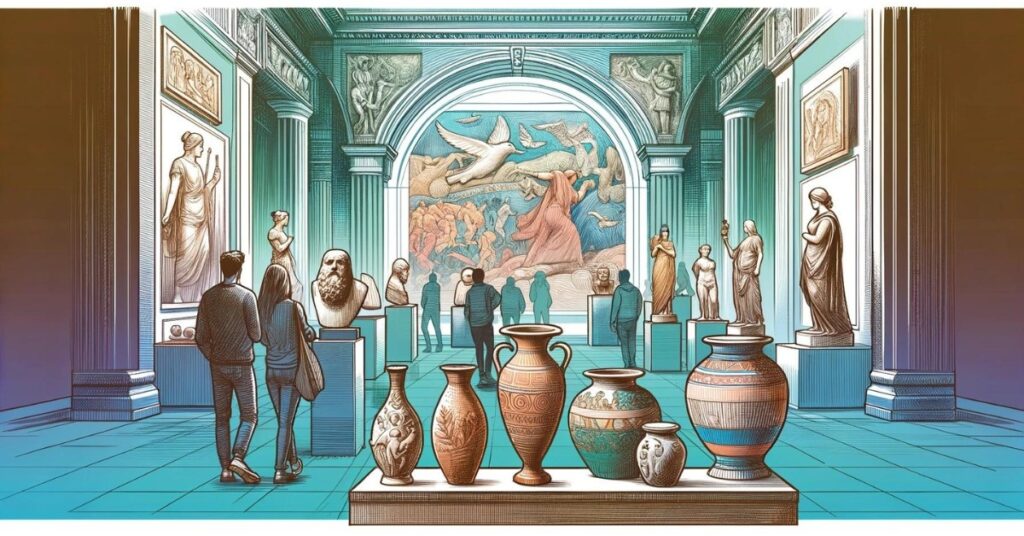Ancient art offers a window into the cultures, beliefs, and values of civilizations long past. From the towering pyramids of Egypt to the breathtaking sculptures of ancient Greece, these masterpieces have not only stood the test of time but continue to inspire and shape modern art. By delving into these ancient artistic traditions, we gain a deeper appreciation of human creativity, perseverance, and cultural legacy.
In this article, we will take a journey through some of the most influential ancient art forms, exploring their origins, significance, and their enduring impact on today’s world.
The Dawn of Art: Prehistoric Beginnings
Cave Paintings and the First Artistic Expressions
The story of ancient art begins with humanity’s earliest attempts to communicate and express themselves through visual means. Prehistoric art, which predates written language, serves as a vital record of early human culture. Found in caves such as Lascaux in France and Altamira in Spain, these paintings depict animals, hunting scenes, and abstract shapes. They are believed to have held spiritual significance, perhaps linked to hunting rituals or early religious beliefs.
The techniques used by these early artists were surprisingly sophisticated. They employed natural pigments made from minerals, charcoal, and even blood, applying them to the cave walls using their hands, brushes, or blowing through hollow reeds. The dynamic forms of the animals and the use of shading demonstrate a keen understanding of movement and perspective, long before these concepts were formalized in art.
Symbolism and Meaning
Prehistoric art was more than mere decoration. These early works are believed to have conveyed important cultural messages, such as social unity, the spiritual relationship between humans and animals, and the connection to nature. These themes would echo throughout the art of many later ancient civilizations.
The Art of Ancient Egypt: Monuments to Eternity
The Significance of Egyptian Art
No discussion of ancient art is complete without examining the grandeur of ancient Egypt. This civilization, which flourished along the Nile for over three millennia, left behind a wealth of artistic treasures, from the towering pyramids of Giza to the intricate reliefs and statues adorning temples and tombs.
Egyptian art was closely tied to the society’s religious and spiritual beliefs. The afterlife was of paramount importance to the Egyptians, and their art reflected this focus. Tombs were designed not only as resting places for the dead but as eternal homes for the soul, and their decoration was meant to ensure a safe passage to the afterlife.
Sculptures and Statues: Icons of Power and Divinity
One of the most enduring aspects of Egyptian art is its sculptural tradition. From the monumental statues of pharaohs, like the iconic seated figure of Ramses II, to the elegant depictions of deities such as Isis and Osiris, Egyptian sculpture was designed to convey power, divine authority, and timelessness.
The style of Egyptian statues is highly recognizable: figures are often portrayed with idealized, youthful features and posed in rigid, formal postures, facing forward with their arms at their sides or crossed over their chests. This aesthetic choice reflected the Egyptians’ desire to present their rulers and gods as eternal, unchanging figures.
The Beauty of Hieroglyphs and Wall Paintings
In addition to sculpture, Egyptian artists were masters of wall painting and relief carving. The walls of temples and tombs were adorned with detailed images of gods, pharaohs, and daily life, rendered in a distinctive style that emphasized clarity and order. Figures were typically shown in profile, with important individuals depicted larger than others to indicate their status.
Hieroglyphs, the intricate writing system of ancient Egypt, were often incorporated into these artworks, blending text and image to tell the story of the deceased or the gods. These beautiful inscriptions were not only functional but also an art form in their own right, with each hieroglyph carefully crafted to be aesthetically pleasing.
Ancient Greece: The Birthplace of Classical Beauty
The Human Form in Greek Sculpture
Ancient Greek art is synonymous with the celebration of the human body. Greek sculptors sought to capture the ideal form, creating lifelike representations of athletes, gods, and heroes that embodied the values of physical perfection and harmony.
The development of Greek sculpture can be traced through several key periods: the Archaic, Classical, and Hellenistic. During the Archaic period, statues like the kouros (nude male youth) were somewhat stiff and stylized, with a focus on symmetry and formality. However, by the Classical period, artists had achieved a remarkable understanding of human anatomy, allowing them to create statues such as the “Discobolus” (the Discus Thrower) by Myron, which captures a figure in dynamic motion with perfect proportion.
The Hellenistic period saw even greater realism and emotional expression in sculpture. Works like the “Laocoön Group” depict intense drama and movement, with intricate details that convey both physical struggle and emotional depth.
Greek Pottery: Telling Stories in Clay
Greek pottery was another important art form, and it provides valuable insight into ancient Greek culture and mythology. Vases, bowls, and amphorae were decorated with scenes from everyday life, as well as mythological narratives featuring gods, heroes, and legendary creatures. Black-figure and red-figure techniques allowed for detailed, intricate depictions of these stories, which were often used in religious or funerary contexts.
Greek pottery is not only prized for its technical mastery but also for its storytelling ability. Each piece is like a visual narrative, providing a glimpse into the values, beliefs, and daily experiences of the people who created it.
The Influence of Greek Art on Western Civilization
The artistic achievements of ancient Greece have had a profound and lasting impact on Western art and culture. The emphasis on realism, proportion, and balance in Greek sculpture set the standard for centuries to come, influencing the Renaissance and continuing to shape modern conceptions of beauty and artistic technique. The ideals of harmony and humanism celebrated by the Greeks continue to resonate in contemporary art and philosophy.
The Majesty of Ancient Rome: Art in Service of Empire
Roman Art and Its Greek Heritage
Roman art was heavily influenced by the Greeks, but it also developed its own distinct style that reflected the grandeur of the Roman Empire. Roman artists adopted many of the techniques of Greek sculpture and architecture but used them to celebrate the power and achievements of the state rather than individual perfection or religious devotion.
Roman portraiture, for example, is notable for its realism, often depicting individuals with great accuracy, including imperfections and signs of aging. This contrasted with the idealized figures of Greek art and was a reflection of Roman values, which emphasized duty, discipline, and the importance of ancestry.
Architectural Marvels: The Colosseum and Beyond
Roman architecture also made significant contributions to the world of art. The Romans were masters of engineering, and their buildings, such as the Colosseum, the Pantheon, and the aqueducts, were not only functional but also works of art in their own right. The use of the arch, the vault, and concrete allowed Roman architects to create structures that were both grand in scale and aesthetically impressive.
Mosaics and frescoes were another important aspect of Roman art, often used to decorate public spaces and the homes of the wealthy. These works ranged from detailed depictions of mythological scenes to elaborate geometric patterns, showcasing the skill and creativity of Roman artists.
The Legacy of Ancient Art: Influencing Modern Creativity
Renaissance and the Revival of Classical Ideals
The influence of ancient art did not end with the fall of these great civilizations. During the Renaissance, artists in Europe looked back to the classical traditions of Greece and Rome for inspiration, leading to a revival of the ideals of proportion, balance, and beauty. Michelangelo’s sculptures and Leonardo da Vinci’s studies of human anatomy, for example, were deeply influenced by the works of ancient Greek sculptors.
Modern Art and Ancient Inspiration
Even in the modern era, ancient art continues to inspire artists and architects. The minimalist forms of ancient sculptures can be seen in the works of 20th-century artists like Constantin Brâncuși, while the grandeur and scale of ancient architecture have influenced contemporary architects such as I. M. Pei and Zaha Hadid.
Moreover, ancient art provides a valuable point of reference for exploring themes of identity, power, and human experience that remain relevant today. Artists continue to engage with the visual language of the past, reinterpreting it in new and innovative ways to comment on contemporary society.
Conclusion
The world of ancient art is vast and endlessly fascinating. From the symbolic cave paintings of prehistoric humans to the monumental sculptures of Egypt, Greece, and Rome, these works of art not only tell us about the societies that created them but also connect us to our shared human heritage. They continue to inspire and influence artists, architects, and thinkers around the world, reminding us of the enduring power of creativity across time.
As we continue to explore these ancient art forms, we are reminded that art is not just a reflection of the past but a bridge to the future—a timeless expression of the human spirit that transcends the ages. Through this journey, we can gain a deeper understanding of how ancient art has shaped the way we see the world and continues to shape the art we create today.







